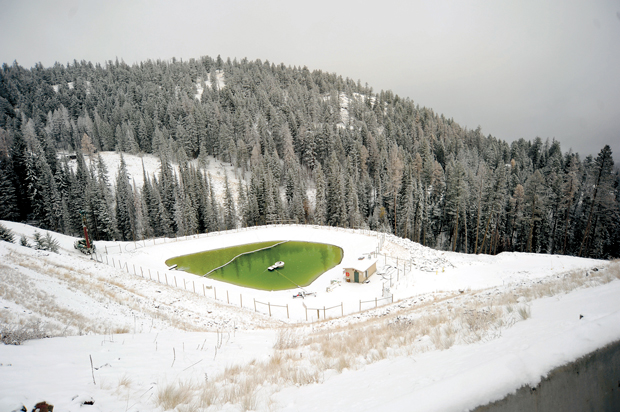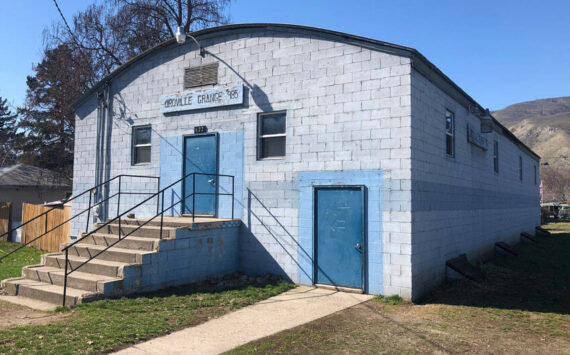$34.9 million in financial securities set aside for gold mine closure


Groundwater and snowmelt in settling pond where water was collected prior to treatment at the Buckhorn Mine near Chesaw.
After working several months to firm up calculations for the environmental security, the Washington Ecology has approved a final closure plan with Crown Resources Corp., a subsidiary of Kinross Gold Corp. In total, $34.9 million in environmental protection performance security will be held by the state during reclamation, as required by state law. Crown Resource’s current investment security is $22.7 million.
However, a local environmental watchdog group feels that $34.9 million is not enough to do a thorough clean up of the mine site. In a recent press release from the group they say, “the bond is based on the mine’s prediction that the groundwater polluted by mining can be cleaned up in three to five years.
The Okanogan Highlands Alliance (OHA), an environmental group working on mining-related issues in the region, believes that the bond and its underlying assumptions are unrealistic and underestimate the resources that will be needed to clean up the site and mitigate the mine’s impacts.
“The EPPS amount required by Ecology falls far short of what is necessary to adequately protect Washington taxpayers,” states David Kliegman, Executive Director of the OHA. “The bond is based on an unrealistic closure plan timeline and fails to protect Washington State’s long-term water quality.”
The Buckhorn Mine closure plan, clean up plan, and bond fail to account for the continuous, unlawful discharges of pollutants into the environment and the complex, time-consuming nature of cleaning up polluted groundwater once it has occurred, according to OHA.
“The troubled mine has been violating its discharge permit throughout the active life of the mine, sending pollution downstream via the small creeks and tributary streams that originate on Buckhorn Mountain. Given the history of the mine’s inability of achieve hydrologic control over the site, it is important that the EPPS be large enough to cover long term treatment,” said the group.
Needless to say, Crown Resources disagrees with OHA’s assessment.
“Preparation and submittal of an Environmental Protection Performance Security (EPPS) cost estimate is required for compliance with the Washington Metals Mining and Milling Act and Crown’s NPDES permit. The recent cost estimate increase and approval was simply the result of a routine update to the existing surety. Crown has regularly updated the cost estimate and will continue to do so as the closure period advances,” said Mark Ioli, President and General Manager for Crown Resources. “Ecology’s approval of Crown’s hydrologic closure plan and associated EPPS cost estimate recognizes Crown’s evidence-driven approach to the protection of water quality at Buckhorn, ensuring that reclamation and closure are completed responsibly and to the highest environmental standards.”
According to Ecology, contaminated water generated by the underground mine can carry high concentrations of heavy metals such as copper, lead and zinc. Routine water quality monitoring indicates the mine’s wastewater has not been adequately captured and treated since opening in 2007 and has migrated to areas outside the mine’s perimeter.
“This commitment by Crown is important because it assures taxpayers won’t be left with a costly cleanup as reclamation occurs at the mine over the next several decades,” said Heather Bartlett, Ecology’s Water Quality program manager.
Ecology anticipates the company will invest $15.1 million over the next seven years to make environmental improvements. And Crown is currently installing a new water treatment plant and recirculation system to more effectively treat water from the mine (at approximately $1.8 million).
The closure plan also acknowledges that reclamation costs could be lower in later years as conditions improve, and associated monitoring is reduced. The financial security estimate is based on projected operational costs. The environmental protection security will be revisited every two years to ensure coverage is adequate.
“During the Buckhorn Mine operation and continuing into closure, Crown’s environmental commitment has included advanced water treatment technologies, stormwater controls, dewatering wells and a comprehensive monitoring system, all resulting in discharge from the water treatment plant to permitted outfalls meeting drinking water standards. The Buckhorn Mine ceased ore production in mid-2017,” said Ioli. “Crown is committed to upholding environmental standards and will continue to work with Ecology during reclamation and closure to meet final closure criteria and maintain appropriate long-term financial assurances.”






